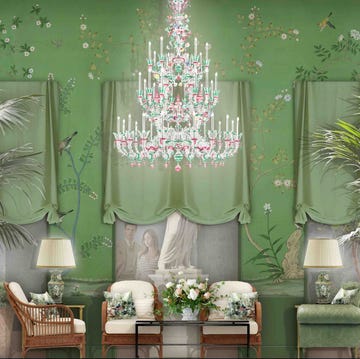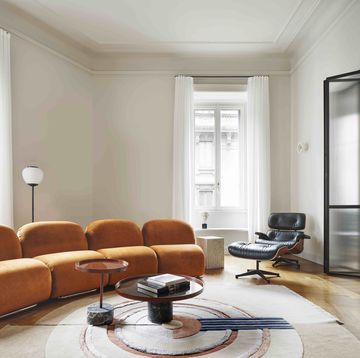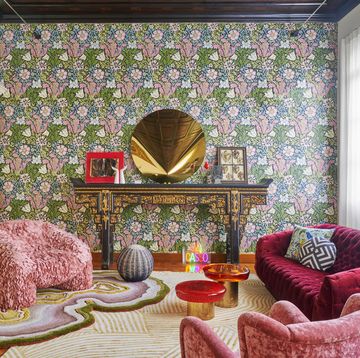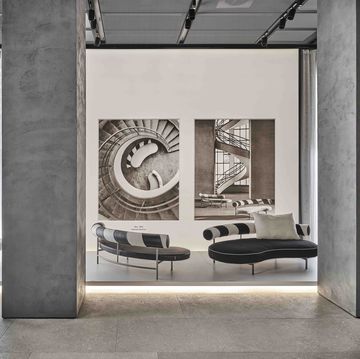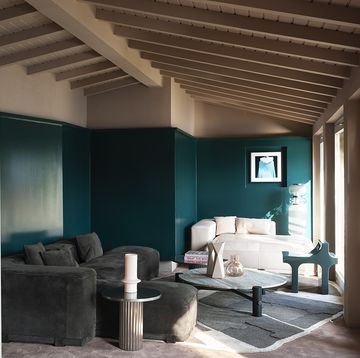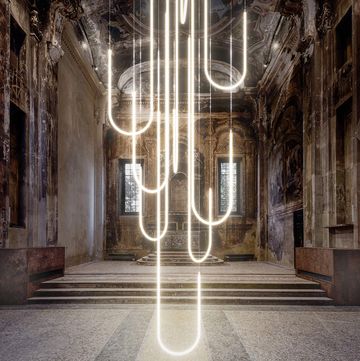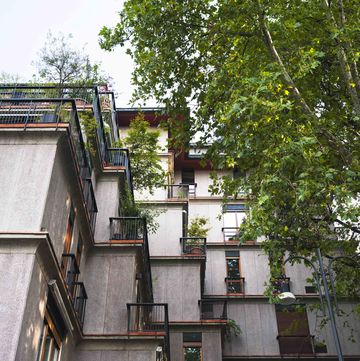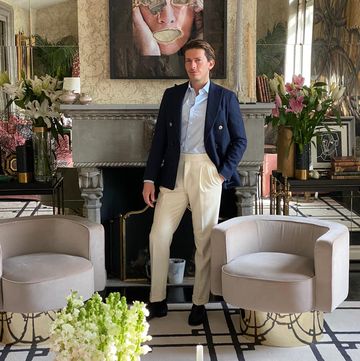From a collection of iridescent sculptural pieces made of resin to a brilliantly coloured range of Liberty fabrics, there was a kaleidoscope of things to discover at this year’s Milan Design Week. We spoke to nine leading designers – the names behind some of the projects that made the biggest splash – to get a unique perspective on designs most inspirational week.
Tom Dixon
‘We were above all interested in taking the bathroom out of the private sphere and giving it a more social and public role,’ Dixon says of his latest installation Metamorphic, which was shown at Milan Design Week in the bustling Brera district. Designed for surface material company Consentino, the installation featured a selection of porous, liquid-like surfaces with water flowing throughout.
‘I was immediately interested in working with innovative materials,’ he explains. ‘Cosentino has invested heavily in technology, robotics and digital and by studying natural stone and the brand has come to offer a range of products that beautifully replicate two million-year-old materials.’
What's everyone reading?
After seeing the manufacturing processes, Dixon and Consentino began working on the installation for the design week, aiming to demonstrate the strength of the materials and the potential of the bathroom. cosentino.com
DimoreStudio
Silence by Dimorestudio co-founders Emiliano Salci and Britt Moran of Dimorestudio took visitors on a journey through 20 years of the brand’s design history in the form of four differently decorated rooms. Each room could be seen through a peephole, giving a glimpse into the various styles, materials, colours and furnishings that the brand has become known for.
‘Our portholes studied and not at all improvised – they say – allow the visitor to look inside, as if he were the director of this set, watching and spying from the camera lens,’ the architect and design duo say.
‘These holes are very intimate spaces that everyone can experience in their own way by taking the time they want,’ they add. ‘We want to frame the scene, the interpretation of things is personal.’ dimorestudio.eu
Luca Nichetto
The relationship between design and music was the focal point of Nichetto’s latest collaboration with piano company Steinway & Sons. Located within the Mohd Officina event space, the aptly named Mohd Symphony installation saw a limited edition Steinway & Sons ‘Nichetto Grand’ piano on display in the heart of the space – the first time the instrument had been displayed in Europe.
The piano is a beautiful piece of furniture, regardless of its function. Inspired by the emotions that can be experienced while attending a concert, Steinway has developed the Spirio technology that allows the piano to have a playlist of five thousand songs recorded by artists. Thus the instrument can play by itself.
Surrounding the unique piano, which has a pre-recorded playlist of 5,000 songs, was an area swathed in suspended white curtains. According to Nichetto, these serve as both a sound solution while creating different zones within the space.
‘The idea of the curtains was born as a unique concept to harmonize music and design,’ the Italian-Swedish designer recalls. ‘Given the architecture of Mohd Officina, we had to find something functional so that the music could resonate in the best possible way as there were echo problems. The problem was practically transformed into the installation; to make the sound performant, the architecture was covered and the drapes made it possible to cut out and organise the various sets.’ steinway.co.uk
Adam Nathaniel Furman for Gubi
As part of ‘TEN: Beyond the Beetle’, an exhibition presented by Copenhagen design house Gubi that celebrates 10 years since GamFratesi created its hugely successful ‘Beetle’ chair (named for its wiry legs and organic curves), the brand invited 10 creatives, including architects, musicians, and fashion designers, to showcase responses to the chair in tribute. One of the group was London-based architect and designer Adam Nathaniel Furman, known for their dynamic and joyous use of colour and pattern.
For the Milan show, in the iconic Bagni Misteriosi, Furman designed ‘Scarabesque’, a fantastical interpretation of the chair that seeks to exaggerate its original form by becoming a two-metre-high, throne-like piece. ‘I wanted to look at the performative and expressive side of beetles,’ they explain. ‘How they sometimes have incredible pearlescent and colourful effects on their carapace.
‘This design turns that into a theatrical, celebratory display of camp and drama, in a dizzying opalescent finish.’ Furman was drawn to Gubi as their core principles seemed to align. ‘I am a huge supporter of brands that make beautifully crafted objects for our domestic spaces that are ethically and sustainably produced, with an eye for detail.’ gubi.com
Patricia Urquiola for Cassina
Set within the historic Palazzo Broggi in Milan, the exhibition ‘Echoes, 50 years of iMaestri’ was designed to showcase 50 years of Cassina, through sketches, research, photographs and iconic pieces. Urquiola, who has close ties with the brand, curated the exhibition with the aim of introducing the brand’s rich narrative history.
‘Cassina decided to tell a beautiful story, linked to 50 years of research, centred on the work of the great masters of design and carried out through direct contact with Foundations,’ she explains. ‘Without ever losing sight of the contemporary, Cassina has always shown great attention to the cultural legacy of the great protagonists of the past, reverberating it in the present as if through an echo.’ cassina.com
Faye Toogood for Maison Matisse
‘When Maison Matisse came to us it was an immediate yes from me,’ explains British designer Faye Toogood of her new furniture and accessories collection, ‘Themes and Variations’, debuted during Milan Design Week. Created for the four-year-old brand, founded by the artist’s family, it was inspired by her time spent in the private archives. Toogood, drawn to a collection of black-and-white drawings and engravings from Dessins: Thèmes et Variations by Henri Matisse, was able to create new work: a first foray into furniture and upholstered pieces for Maison Matisse.
‘I wanted to focus on the shapes within the drawings rather than the colour palette,’ she explains of the colourless collection. ‘By sketching the different parts of Matisse’s drawings I built up an A-Z of shape, pattern and mark-making. Within those forms I found a chair, tables. Then, by putting some of them together, I found the rugs, blankets and cushions.’
For Toogood, the collection, created using bouclé for the chair (pictured), laminated plywood for the stool and tables, and pure, undyed wool for the rugs, aligns perfectly with her broader studio practice and its sculptural design language. ‘Maison Matisse allowing me to push the boundaries a bit with its current palette of materials and furniture has been fantastic. As an art historian, this is thrilling and an honour,’ she says. maison-matisse.com
Michael Anastassiades for Flos
London-based designer Anastassiades explored his fascination with light with ‘My Circuit’, his site-specific installation for Flos. While this is not the first time the designer has collaborated with the Italian lighting company, he argues that this collection is far more ‘freeflowing’ and expressive than ever before.
‘A lot has changed since the first system, presented in 2019, and this year’s is a new circuit, based on an innovative, totally flexible system that allows total freedom of expression and transforms the electrical track into a decorative ceiling element,’ he recalls. ‘For the first time, free, organic configurations can be created, as if the electrical tracks were the strokes of a freehand drawing.’ flos.com
‘FuturLiberty’ by Liberty
A new interiors-textile launch, ‘FuturLiberty’, created in collaboration with nonagenarian legendary couturier and interior designer Federico Forquet, debuted at Design Week across two landmark exhibitions: Museo del Novecento and Palazzo Morando.
Overseen by Liberty’s head of design – interiors, Genevieve Bennett, the collection of textiles for fashion and the home, created by Liberty’s fabrics design director Mary-Ann Dunkley, is a more geometric, abstract and bold series of patterns than we’re perhaps used to seeing from Liberty.
Inspiration has been drawn from the brand’s famed creative designer from the 1960s, Bernard Nevill, who loved 20th-century avant-garde art, especially the Italian Futurists. ‘We spent time with Federico in his home in Tuscany, responding to his approach to colour and pattern and exploring what we could learn from this great master,’ says Bennett. ‘The aim was to take painterly techniques, and work on amazing developments of weave, embroidery and print.’
The results are dynamic and beautiful, but also liveable. Standouts include the Memphis-tinged ‘Explosion’ (above, in its ‘Carnavale’ colourway) and ‘Tudor Columns’, which pulls from architectural influences. The collection also features cushions and throws. libertylondon.com
Nina Yashar on Nilufar
Light bounces off the pearly coloured seats, tables and objects in Objects of Common Interest’s ‘Poikilos’ installation, which translates from Greek to mean ‘of beauty, variety and multiplicity’.
The installation, which is spread across the ground floor of the Nilufar Depot, is one of a number of different installations in the building curated by founder of studio Vedèt Valentina Ciuffi.
Nina Yashar, frequent collaborator with Ciuffi believes that ‘the exhibitions of Poikilos by Objects of Common Interest in the atrium of the Depot and Bi.li.co by Maximilian Marchesani on the ground floor of via Spiga have light and nature as their common thread, as the title The Bright Side of Design suggests.’ nilufar.com
John Pawson for Wästberg
‘I’ve been mindful that I ought to have a light-fitting collection – a standard lamp, desk lamp and so on,’ says British architect John Pawson of his second collaboration with the 15-year-old Swedish lighting brand Wästberg, launched during Milan Design Week.
His first resulted in the minimalist ‘Holocene No 4’ lantern designed in 2017. ‘I realised I do need light fittings, decorative in a way (not a word I’d normally use) on tabletops and that level in the middle of a space. You can’t just use walls,’ he admits. ‘Then, I had this opportunity to create a much more sculptural piece, which I designed with Chris Masson, who works in my studio.’
That piece, the ‘W223 Pawson’ (pictured above), is an elegant and ‘quietly monumental form’, with a distinctive, notched profile, crafted in white Carrara marble or a smooth, white powder-coated aluminium. Minimalist, of course. The marble version is solid, so projects a soft luminosity that glows through the stone when lit.
‘It’s always been my favourite stone,’ admits Pawson. ‘People do try and put you off. Clients from Chicago will say it’s a bathroom marble because all the men’s lavatories are beautiful white Carrara there.’ The aluminium version has a different effect, emitting light from front and back. ‘It’s hollow and seamless, so is all about the shadows and reflections,’ Pawson says. ‘The idea is that the curves, the rectangles and the cantilever and notch are like a mini building – but not really’. wastberg.com
Edward Barber and Jay Osgerby for Marsotto
The triangular form is a familiar one for the award-winning British design duo, Barber Osgerby – most notably, in their perforated metal torch for the 2012 London Olympics and the ‘Poppins’ umbrella stands for Magis. The pair’s new ‘Largo’ collection for Italian marble specialists Marsotto, which launched mid-April as a solo exhibition at the company’s headquarters, applies the same simple geometry to a series of marble tables.
Smooth oval or round tabletops sit on substantial triangular bases as a dining table, a low coffee table – both with two legs – and a pair of small, cantilevered side tables with a single leg. On the point of the axis of the triangle, there’s a little visible circle on the table’s surface.
‘The Marsotto building in Milan is on a street called Largo Claudio Treves,’ says Barber. ‘The street is divided in two by a diagonal, making two triangles – that shape forms the basis of the tables. Largo also means big, wide, spacious, and these tables are quite generous.’
The new pieces come in white Carrara, black Nero Marquina and green Verdi Alpi marble – all sourced in Italy. The ‘Largo’ series will become part of the Marsotto Edizioni collection, which includes pieces by fellow Brits Jasper Morrison and David Chipperfield, among others. edizioni.marsotto.com
Rossana Orlandi
In the RoDistrict in Via Matteo Bandello Rossana Orlandi presented a diverse and sustainable contemporary design exhibition that centred on the future of design.
‘We received some very stimulating prototypes that I think could represent the future of design,’ Orlandi says. ‘As many as 600 arrived, but we selected 200 of them, divided into the three categories Art & Collectible Design, Emerging High Technology and Inspiring Learning Project.’ rossanaorlandi.com
























